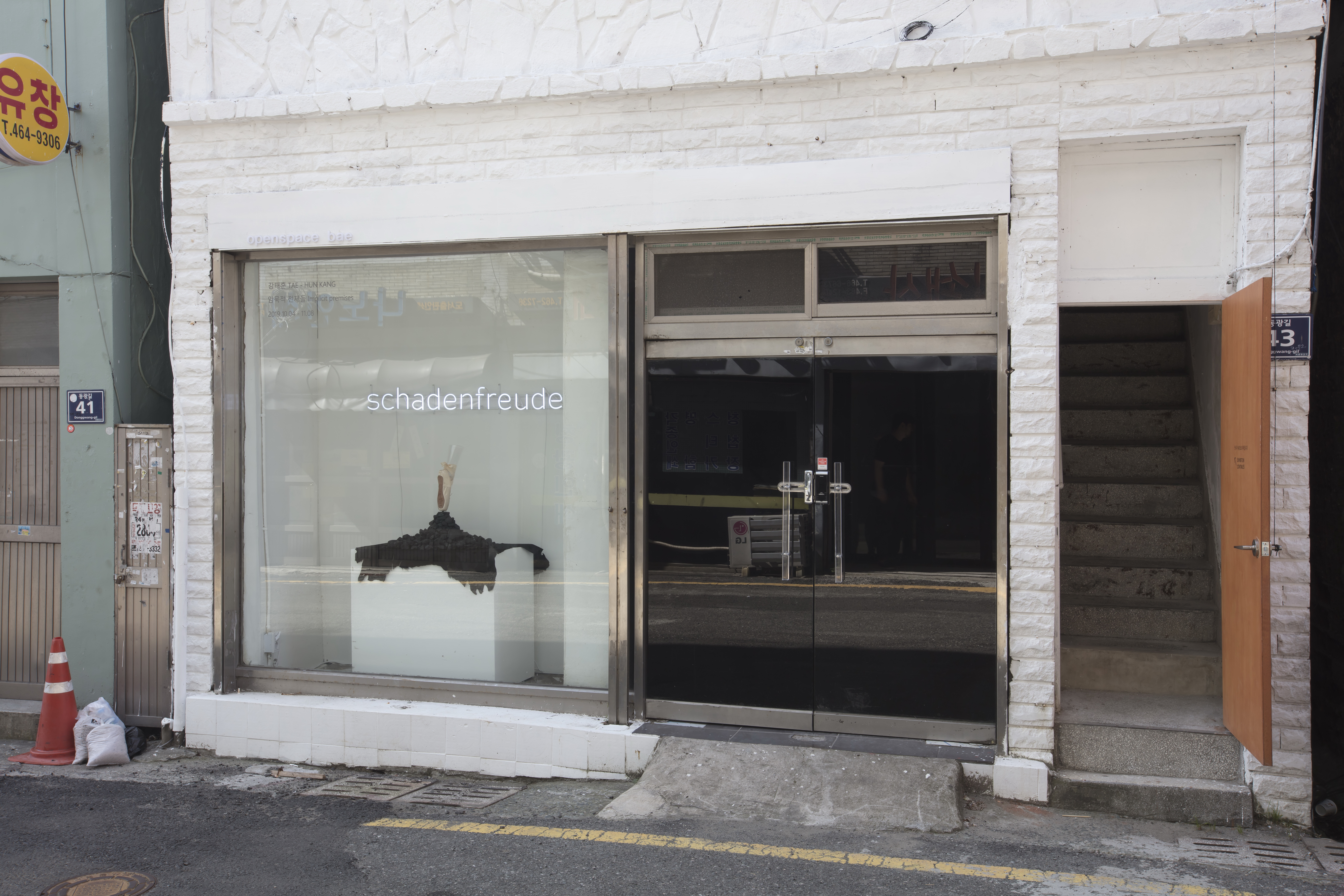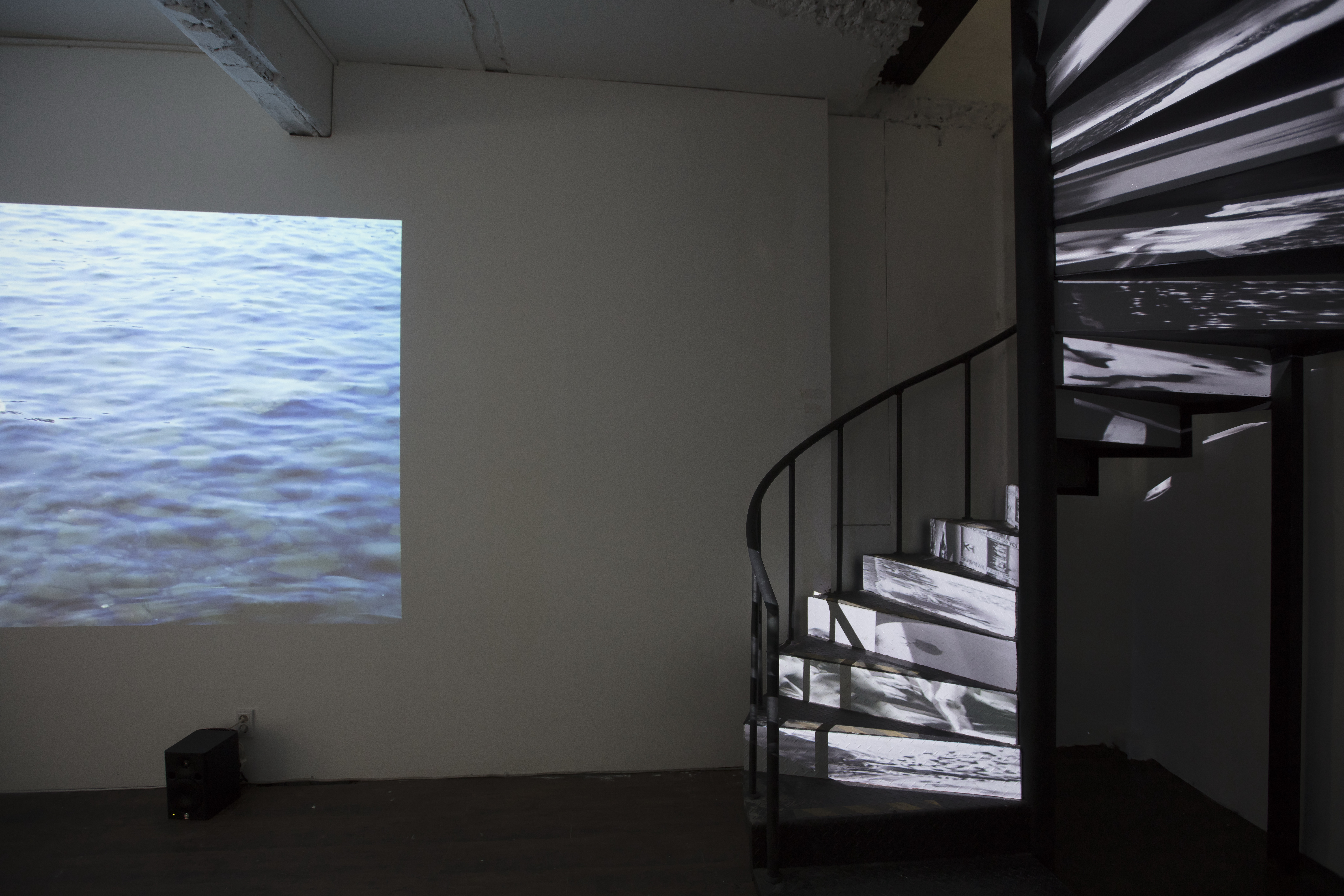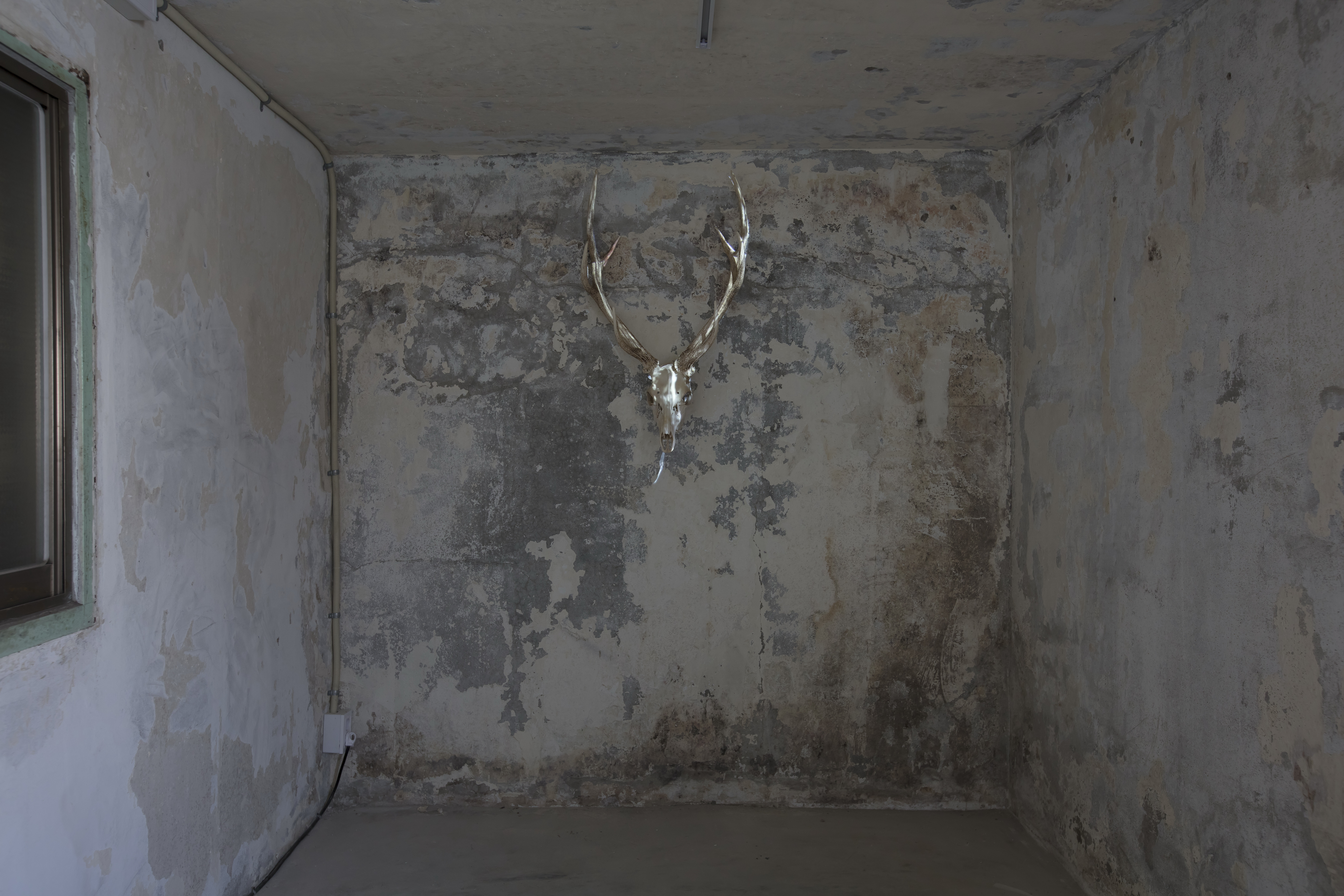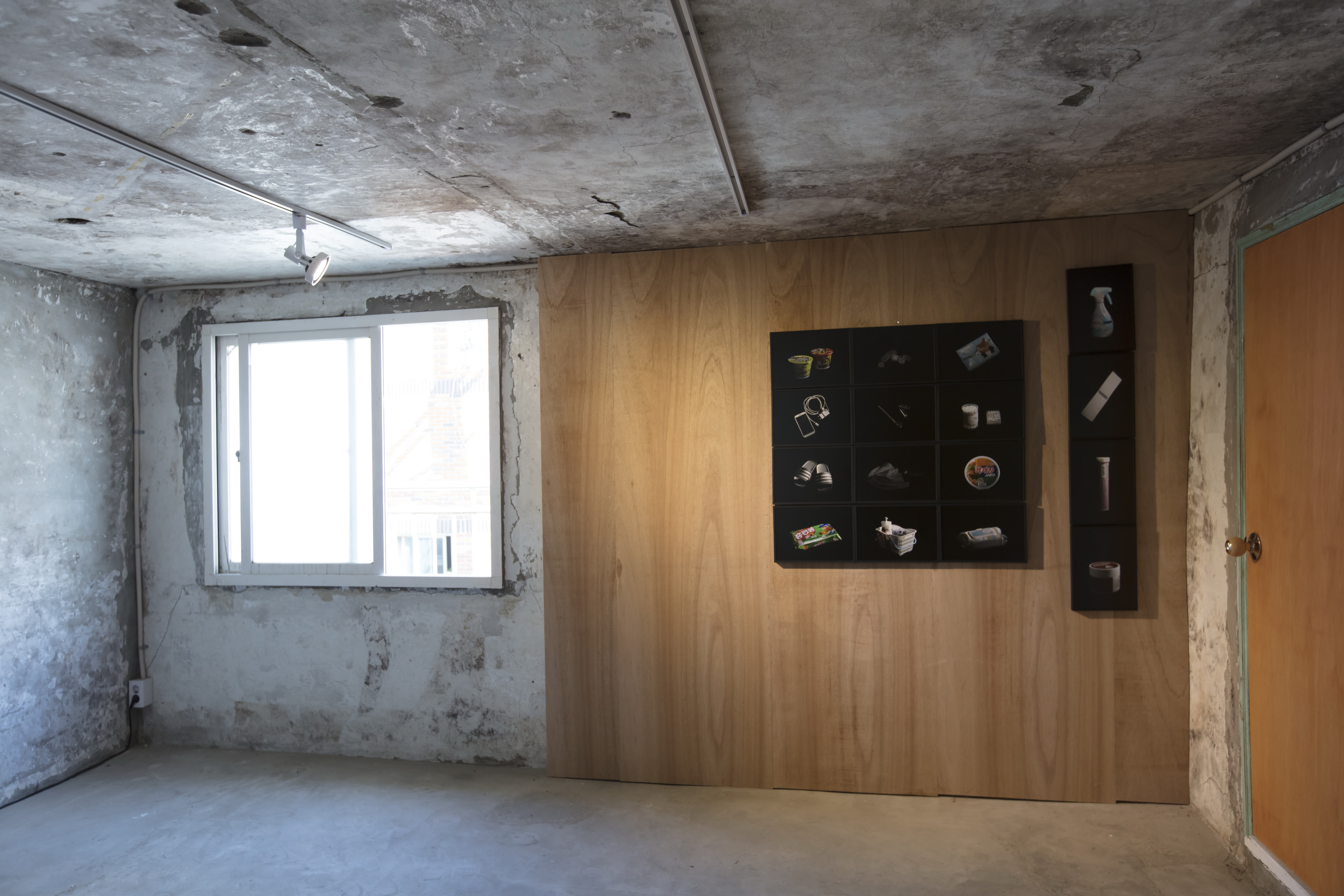






암묵적 전제들
오픈스페이스 배
2019. 10. 4 - 11. 8
강태훈
The implicit premises
Open Space Bae
Oct. 4. 2019 - Nov. 8
Kang Tae Hun
Download ↓
도록
오픈스페이스 배
2019. 10. 4 - 11. 8
강태훈
The implicit premises
Open Space Bae
Oct. 4. 2019 - Nov. 8
Kang Tae Hun
Download ↓
도록
시대와 역사를 마주함에 있어 예술은 어떠한 태도를 취해야 하는가. 강태훈은 비판적
시각을 견지하며 현실세계의 문제적 증상을 포착해왔다. 그것은 발 딛고 있는 현실에 더 가까이 다가가려는
시도이자 모순 가득한 세계의 작동원리를 파악하고자 함이었다. 그러나 문제의 본질에 다가가려 할수록 분명한
실체는 그 무언가에 의해 가려지고 흔들린다. 뚜렷한 징후로 드러나기 이전에 왜곡되는 진실, 그 모든 것을 온전히 자각할 수 없는 인식의 한계, 스스로 그 실체를
드러내기 전까지 발언되지 않는 것들. 강태훈은 점점 수면 아래로 잠겨가는 실체와 직면하기를, 그리하여 현실과 마주할 것을 제시한다.
〈여기에 뼈가 있다 #1〉. 물이 차오른다. 그리고 그 안에 사슴 뼈가 있다. 수면 아래 놓인 뼈는 서서히 차오르는 바닷물에 잠겨간다. 뼈는 죽음 후에 남은 것, 이미 사라지고 없어진 육신의 증거물이다. 그러나 동시에 뼈는 육체를 상상할 수 있게 하는 힘을 지녔다. 그렇기에 생명의 흔적을 증언하는 중요한 단서가 된다. 또한 이 뼈 역시 시간이 흐르면 사라져 최후의 죽음을 맞이할 것이다. 이처럼 뼈는 과거와 미래를 담지한 현재를 상징한다. 수면 아래 뼈는 언제부터 어떻게 여기에 있게 된 것인지 그 연유를 알 수가 없다. 마치 역사의 흐름 속 현재를 마주한 개인과 같다. 나는 왜 이 시기, 이 공간에 있는가. 이 시대의 흐름은 어떠한 방향으로 가고 있는가. 그 까닭을 명확히 알 수가 없다.
이것을 지켜볼 화면 밖의 나는 더더욱 알 수가 없다. 어른거리는 물결이 만들어낸 굴곡은 형상의 표면을 굴절시켜 알아보지 못하게 한다. 방법은 차라리 물속으로 들어가는 것. 수중에서 마주한 뼈는 보다 선명해진다. 그 순간 망자의 혀에서 나온 듯 알 수 없는 소리가 웅얼거린다. 그것은 삶의 회한일 수도, 원망 섞인 분노의 외침일 수도, 미래를 암시하는 예언의 말일 수도 있을 것이다. 그러나 시야가 확보된 수중에서 소리는 굴절되어 알아들을 수 없다. 실체에 다가가려는 시도가 무색하게 인식의 한계에 부딪힌다.
〈여기에 뼈가 있다 #2〉. 그렇다면 또 하나의 방법은 실체를 끄집어내는 것. 영상과 떨어진 4층의 방 안에서 그 실체를 마주하게 된다. 바로 그 뼈다. 그 위로 혁명을 외치는 행렬이 투사된다. 과거의 사건이 현재의 상징물에 투영된다. 역사로 편입된 지난 사건이 되살아난다. 그것은 그 외침이 현재에도 유효함을, 사회 모순에 분노하며 단결했던 군중이 보여준 투쟁 의지가 살아있어야 함을 암시한다. 어떤 사람에게는 눈앞의 손바닥만한 화면 속 시간이 현재이지만, 어떤 사람에게는 역사적 과오와 아픔까지도 현재로 편입된다. 그리고 그 현재의 두께는 미래를 결정짓는 거름이 된다. 그렇기에 현실을 직시하는 것은 과거와 분리될 수 없음을 의미한다. 그렇다면 강태훈이 강조하여 나타내고자 하는 현실은 어떤 것인가.
〈노동이 너희를 자유롭게 하리라〉 투채널 영상이 벽 모서리에 직각을 이루고 있다. 왼쪽 화면에는 소금 위에서 격렬히 꿈틀대는 미꾸라지가, 오른쪽에는 위험한 노동의 현장과 사고 현장, 폭발 장면 등이 게임, 만화의 장면과 몽타주되어 반복된다. 미꾸라지가 몸부림치는 영상은 잔혹해 보이지만 오히려 역동적인 생(生)에 가깝다. 그러나 대조를 위해 구분하자면 그것은 인간이 아니다(not human). 그리고 이와 반대로, 인간의 노동현장이 등장하는 오른쪽 영상은 위험에 노출된 어두운 죽음(死)의 분위기가 드리워져 있다. 크레인은 무게를 이기지 못해 거꾸러지고, 어둡고 축축한 지하로 향하는 맨손의 노동자는 위태로워 보인다. 내몰린 노동 한가운데에서 목숨을 존중받지 못하는 삶, 그것은 비인간(inhuman)이다. 그렇다면 어느 것이 더 끔찍하고 잔혹한가. 강태훈은 묻는다.
인간이 인간에게 가하는 비인간적 폭력은 도처에 만연한데 그것이 마치 만화나 게임의 가상세계인 듯 무감각해진다. 이러한 비극적 현실은 소금구덩이를 벗어나지 않으면 계속될 미꾸라지의 몸부림처럼 시스템의 변혁 없이는 바뀌지 않을 것임을 보여주고 있다. 〈남겨진 것들의 전언〉은 실제 불합리한 시스템 속에서 목숨을 잃은 두 젊음을 이야기한다. 여기서 강태훈은 그 사건에 대해 사물이 직접 말하도록 내버려 둔다. 그것은 비참한 죽음의 감정적 상흔을 드러내고 애도함으로써 끝내지 않기 위함이다. 발전소와 지하철의 비정규직으로 근무 중 사고를 당한 두 김군의 유품은 그것이 비단 개별적 사건이 아니었음을 말해준다.
거듭되는 삶과 죽음이 역사를 만들기에, 개개인의 생과 사는 따로 분리될 수 없다. 살아있으나 죽은 것과 같은 이들과, 죽음으로서 되살아나는 이들은 시대와 역사라는 한 축을 중심으로 서로 공존한다. 〈Dead-end〉 막다른 길에 다다르듯 혼란과 무질서로 점철된 현실이 원형계단의 층계를 따라 어지럽게 아른거린다. 그러나 아직 흔들리지 않은 중심축이 있기에 바로잡기 위한 현실 직시가 필요하다. 죽음을 기억하고 문제에 직면하고 분노를 통해 합리적 저항력을 갖추는 것. 그것이 왜곡된 진실, 인식의 한계와 맞서 발언되지 않는 것을 밝혀내는 방법일 것이다.
강태훈의 지향점은 〈덧 칠 된 깃발〉과 같은 것일지 모르겠다. 실패한 역사로 간주 된 소련의 국기에 붉은색을 거듭 칠하는 그의 행위는 현실과 이상 사이의 공백을 채우고, 역사의 보편적 진리를 찾아 앞으로 나가기 위함일 것이다. 그의 계급적 비판의식이 가장 잘 드러난 〈죽음 위의 갈라쇼〉에서처럼 분명 착취와 억압으로 일궈낸 예술의 일면이 존재하지만, 또한 한편으로 예술은 현실 체제의 전복을 꿈꾸게 하고 부조리와 모순을 폭로할 수 있는 무기가 될 수 있기에, 사유에 뿌리를 둔 강태훈의 비판적 예술 실천이 앞으로도 계속될 것이라 기대한다.
추희정(오픈스페이스 배 큐레이터)
What attitude should art take in facing the times and history? Kang Taehun has maintained a critical view and detected the problematic symptoms of the real world. It was an attempt to get closer to reality and to grasp the operating principles of the contradictory world. However, the more you approach the essence of the problem, the obvious substance is obscured and shaken by something. The truth which is distorted before it appears as the clear signs, the limits of perception that cannot be fully aware of what it all, comments that are not stated until it exposes the truth. Kang Taehun suggests facing a gradually submerged truth into the water and that it faces reality.
〈Here is the bone #1〉. The water is rising. And there's a deer bone in it. The bones under the surface of the water slowly sink into the rising seawater. The bones are evidence of the body that has vanished and disappeared after death. However, at the same time, bones have the power to enable the imagining of the body. Therefore, it is an important clue to testifying to the signs of life. This bone will also disappear over time and face death. As such, bones represent the present, which contains the past and the future. The bones below the surface of the water do not tell how they came to be here. It is like an individual facing the present in the stream of history. Why am I at this time of year, in this space? What direction is the current of this era going? The reason for that is not clear.
It is impossible to know much more as I am outside the screen watching this. The curves created by the wave bend the surface of the form so that it cannot be recognized. The way is to go into the water. Bones faced underwater become clearer. At that moment, the mysterious sound as if it is coming out of the dead man's tongue hums. It could be repentance of life, a cry of anger mixed with resentment, or a prophetic remark suggesting the future. However, in the water where visibility is secure, the sound is refracted and incomprehensible. Attempts to reach the truth faces limitations of perception.
〈Here is the bone #2〉. Then another way is to bring out the substance. In a room on the fourth floor away from the video, face the substance. That is the bone. On top of that, a procession calling for revolution is projected. Past events are projected onto the current symbol. Past events that have been transferred into history are revived. It suggests that the cry is still valid today and that the fighting will be shown by the united masses in anger at social contradictions must be alive. For some, the moment in the screen which is the size of a palm is the present, but for others, historical wrongs and pains are transferred into the present. And the current thickness becomes the manure that determines the future. That's why facing reality means that it cannot be separated from the past. Then, what reality does Kang want to emphasize?
〈Let the labour set you free〉 A two-channel video is right at the edge of the wall. On the left screen, mudfish wriggling furiously over salt, on the right, the scene with images of dangerous labor, accident, explosion, and more are repeated with images of games, cartoons and sketched. The images of the mudfish struggle seem cruel, but it is more like a dynamic life. However, if separate for contrast, it is not human. On the contrary, the right-hand video featuring the images of human laboring has an atmosphere of dark death exposed to danger. Cranes fail to win the heavyweight, and bare-handed workers heading for dark, damp basement look precarious. A life that is not respected in forced labor, it is inhuman. Then which one is more horrible and cruel? Kang Taehun asks.
The inhumane violence that humans inflict on humans is rampant everywhere, it becomes numb as if it was a virtual world of cartoons or games. This tragic reality shows that it will not change without a system change, just like the mudfish's struggle that will continue unless you get out of the salt. 〈The message of the remains〉 tells the story of two young men who lost their lives in an irrational system. Here, Kang lets the objects themselves talk about the accident. It is not to end by showing the emotional scars of the miserable death and mourning. The articles left by the two Kims, who had the accidents while on duty as temporary employees each at the power station and subway station, indicate that they were not separate incidents.
Since repeated life and death make history, individual lives cannot be separated. Those who are alive but are dead and those who are brought back by death coexist around one axis of time and history. 〈Dead-end〉 As we approach the dead-end, chaos and disorder run wild along with the steps of the circular staircase. However, since there is a central axis that has yet to be shaken, facing the reality is needed to correct it. To remember death, to face problems, and to have rational resistance through anger. That would be the way to uncover what is not spoken against the distorted truth, the limitations of perception.
The destination of the artist might be like the 〈Recoated flag (red on red)〉. His act of repeatedly painting red on the Soviet flag, regarded as a failed history, would fill the void between reality and ideals and is to move forward in search of the universal truths of history. While there is certainly a facet of art that has been created by exploitation and oppression, as in the 〈The gala on the death〉, where the artist’s sense of class criticism is best revealed, on the other hand, art can be a weapon that can dream the overthrow of the current system and expose absurdities and contradictions, Kang Taehun's critical art practice based on thinking will continue.
Chu Hyi jeong Open Space Bae, Curator
〈여기에 뼈가 있다 #1〉. 물이 차오른다. 그리고 그 안에 사슴 뼈가 있다. 수면 아래 놓인 뼈는 서서히 차오르는 바닷물에 잠겨간다. 뼈는 죽음 후에 남은 것, 이미 사라지고 없어진 육신의 증거물이다. 그러나 동시에 뼈는 육체를 상상할 수 있게 하는 힘을 지녔다. 그렇기에 생명의 흔적을 증언하는 중요한 단서가 된다. 또한 이 뼈 역시 시간이 흐르면 사라져 최후의 죽음을 맞이할 것이다. 이처럼 뼈는 과거와 미래를 담지한 현재를 상징한다. 수면 아래 뼈는 언제부터 어떻게 여기에 있게 된 것인지 그 연유를 알 수가 없다. 마치 역사의 흐름 속 현재를 마주한 개인과 같다. 나는 왜 이 시기, 이 공간에 있는가. 이 시대의 흐름은 어떠한 방향으로 가고 있는가. 그 까닭을 명확히 알 수가 없다.
이것을 지켜볼 화면 밖의 나는 더더욱 알 수가 없다. 어른거리는 물결이 만들어낸 굴곡은 형상의 표면을 굴절시켜 알아보지 못하게 한다. 방법은 차라리 물속으로 들어가는 것. 수중에서 마주한 뼈는 보다 선명해진다. 그 순간 망자의 혀에서 나온 듯 알 수 없는 소리가 웅얼거린다. 그것은 삶의 회한일 수도, 원망 섞인 분노의 외침일 수도, 미래를 암시하는 예언의 말일 수도 있을 것이다. 그러나 시야가 확보된 수중에서 소리는 굴절되어 알아들을 수 없다. 실체에 다가가려는 시도가 무색하게 인식의 한계에 부딪힌다.
〈여기에 뼈가 있다 #2〉. 그렇다면 또 하나의 방법은 실체를 끄집어내는 것. 영상과 떨어진 4층의 방 안에서 그 실체를 마주하게 된다. 바로 그 뼈다. 그 위로 혁명을 외치는 행렬이 투사된다. 과거의 사건이 현재의 상징물에 투영된다. 역사로 편입된 지난 사건이 되살아난다. 그것은 그 외침이 현재에도 유효함을, 사회 모순에 분노하며 단결했던 군중이 보여준 투쟁 의지가 살아있어야 함을 암시한다. 어떤 사람에게는 눈앞의 손바닥만한 화면 속 시간이 현재이지만, 어떤 사람에게는 역사적 과오와 아픔까지도 현재로 편입된다. 그리고 그 현재의 두께는 미래를 결정짓는 거름이 된다. 그렇기에 현실을 직시하는 것은 과거와 분리될 수 없음을 의미한다. 그렇다면 강태훈이 강조하여 나타내고자 하는 현실은 어떤 것인가.
〈노동이 너희를 자유롭게 하리라〉 투채널 영상이 벽 모서리에 직각을 이루고 있다. 왼쪽 화면에는 소금 위에서 격렬히 꿈틀대는 미꾸라지가, 오른쪽에는 위험한 노동의 현장과 사고 현장, 폭발 장면 등이 게임, 만화의 장면과 몽타주되어 반복된다. 미꾸라지가 몸부림치는 영상은 잔혹해 보이지만 오히려 역동적인 생(生)에 가깝다. 그러나 대조를 위해 구분하자면 그것은 인간이 아니다(not human). 그리고 이와 반대로, 인간의 노동현장이 등장하는 오른쪽 영상은 위험에 노출된 어두운 죽음(死)의 분위기가 드리워져 있다. 크레인은 무게를 이기지 못해 거꾸러지고, 어둡고 축축한 지하로 향하는 맨손의 노동자는 위태로워 보인다. 내몰린 노동 한가운데에서 목숨을 존중받지 못하는 삶, 그것은 비인간(inhuman)이다. 그렇다면 어느 것이 더 끔찍하고 잔혹한가. 강태훈은 묻는다.
인간이 인간에게 가하는 비인간적 폭력은 도처에 만연한데 그것이 마치 만화나 게임의 가상세계인 듯 무감각해진다. 이러한 비극적 현실은 소금구덩이를 벗어나지 않으면 계속될 미꾸라지의 몸부림처럼 시스템의 변혁 없이는 바뀌지 않을 것임을 보여주고 있다. 〈남겨진 것들의 전언〉은 실제 불합리한 시스템 속에서 목숨을 잃은 두 젊음을 이야기한다. 여기서 강태훈은 그 사건에 대해 사물이 직접 말하도록 내버려 둔다. 그것은 비참한 죽음의 감정적 상흔을 드러내고 애도함으로써 끝내지 않기 위함이다. 발전소와 지하철의 비정규직으로 근무 중 사고를 당한 두 김군의 유품은 그것이 비단 개별적 사건이 아니었음을 말해준다.
거듭되는 삶과 죽음이 역사를 만들기에, 개개인의 생과 사는 따로 분리될 수 없다. 살아있으나 죽은 것과 같은 이들과, 죽음으로서 되살아나는 이들은 시대와 역사라는 한 축을 중심으로 서로 공존한다. 〈Dead-end〉 막다른 길에 다다르듯 혼란과 무질서로 점철된 현실이 원형계단의 층계를 따라 어지럽게 아른거린다. 그러나 아직 흔들리지 않은 중심축이 있기에 바로잡기 위한 현실 직시가 필요하다. 죽음을 기억하고 문제에 직면하고 분노를 통해 합리적 저항력을 갖추는 것. 그것이 왜곡된 진실, 인식의 한계와 맞서 발언되지 않는 것을 밝혀내는 방법일 것이다.
강태훈의 지향점은 〈덧 칠 된 깃발〉과 같은 것일지 모르겠다. 실패한 역사로 간주 된 소련의 국기에 붉은색을 거듭 칠하는 그의 행위는 현실과 이상 사이의 공백을 채우고, 역사의 보편적 진리를 찾아 앞으로 나가기 위함일 것이다. 그의 계급적 비판의식이 가장 잘 드러난 〈죽음 위의 갈라쇼〉에서처럼 분명 착취와 억압으로 일궈낸 예술의 일면이 존재하지만, 또한 한편으로 예술은 현실 체제의 전복을 꿈꾸게 하고 부조리와 모순을 폭로할 수 있는 무기가 될 수 있기에, 사유에 뿌리를 둔 강태훈의 비판적 예술 실천이 앞으로도 계속될 것이라 기대한다.
추희정(오픈스페이스 배 큐레이터)
What attitude should art take in facing the times and history? Kang Taehun has maintained a critical view and detected the problematic symptoms of the real world. It was an attempt to get closer to reality and to grasp the operating principles of the contradictory world. However, the more you approach the essence of the problem, the obvious substance is obscured and shaken by something. The truth which is distorted before it appears as the clear signs, the limits of perception that cannot be fully aware of what it all, comments that are not stated until it exposes the truth. Kang Taehun suggests facing a gradually submerged truth into the water and that it faces reality.
〈Here is the bone #1〉. The water is rising. And there's a deer bone in it. The bones under the surface of the water slowly sink into the rising seawater. The bones are evidence of the body that has vanished and disappeared after death. However, at the same time, bones have the power to enable the imagining of the body. Therefore, it is an important clue to testifying to the signs of life. This bone will also disappear over time and face death. As such, bones represent the present, which contains the past and the future. The bones below the surface of the water do not tell how they came to be here. It is like an individual facing the present in the stream of history. Why am I at this time of year, in this space? What direction is the current of this era going? The reason for that is not clear.
It is impossible to know much more as I am outside the screen watching this. The curves created by the wave bend the surface of the form so that it cannot be recognized. The way is to go into the water. Bones faced underwater become clearer. At that moment, the mysterious sound as if it is coming out of the dead man's tongue hums. It could be repentance of life, a cry of anger mixed with resentment, or a prophetic remark suggesting the future. However, in the water where visibility is secure, the sound is refracted and incomprehensible. Attempts to reach the truth faces limitations of perception.
〈Here is the bone #2〉. Then another way is to bring out the substance. In a room on the fourth floor away from the video, face the substance. That is the bone. On top of that, a procession calling for revolution is projected. Past events are projected onto the current symbol. Past events that have been transferred into history are revived. It suggests that the cry is still valid today and that the fighting will be shown by the united masses in anger at social contradictions must be alive. For some, the moment in the screen which is the size of a palm is the present, but for others, historical wrongs and pains are transferred into the present. And the current thickness becomes the manure that determines the future. That's why facing reality means that it cannot be separated from the past. Then, what reality does Kang want to emphasize?
〈Let the labour set you free〉 A two-channel video is right at the edge of the wall. On the left screen, mudfish wriggling furiously over salt, on the right, the scene with images of dangerous labor, accident, explosion, and more are repeated with images of games, cartoons and sketched. The images of the mudfish struggle seem cruel, but it is more like a dynamic life. However, if separate for contrast, it is not human. On the contrary, the right-hand video featuring the images of human laboring has an atmosphere of dark death exposed to danger. Cranes fail to win the heavyweight, and bare-handed workers heading for dark, damp basement look precarious. A life that is not respected in forced labor, it is inhuman. Then which one is more horrible and cruel? Kang Taehun asks.
The inhumane violence that humans inflict on humans is rampant everywhere, it becomes numb as if it was a virtual world of cartoons or games. This tragic reality shows that it will not change without a system change, just like the mudfish's struggle that will continue unless you get out of the salt. 〈The message of the remains〉 tells the story of two young men who lost their lives in an irrational system. Here, Kang lets the objects themselves talk about the accident. It is not to end by showing the emotional scars of the miserable death and mourning. The articles left by the two Kims, who had the accidents while on duty as temporary employees each at the power station and subway station, indicate that they were not separate incidents.
Since repeated life and death make history, individual lives cannot be separated. Those who are alive but are dead and those who are brought back by death coexist around one axis of time and history. 〈Dead-end〉 As we approach the dead-end, chaos and disorder run wild along with the steps of the circular staircase. However, since there is a central axis that has yet to be shaken, facing the reality is needed to correct it. To remember death, to face problems, and to have rational resistance through anger. That would be the way to uncover what is not spoken against the distorted truth, the limitations of perception.
The destination of the artist might be like the 〈Recoated flag (red on red)〉. His act of repeatedly painting red on the Soviet flag, regarded as a failed history, would fill the void between reality and ideals and is to move forward in search of the universal truths of history. While there is certainly a facet of art that has been created by exploitation and oppression, as in the 〈The gala on the death〉, where the artist’s sense of class criticism is best revealed, on the other hand, art can be a weapon that can dream the overthrow of the current system and expose absurdities and contradictions, Kang Taehun's critical art practice based on thinking will continue.
Chu Hyi jeong Open Space Bae, Curator